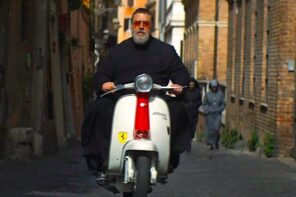Andrea Jain’s timely piece in RD sets Pope Francis’ recent inoffensive reference to yoga against a larger context of yogaphobia in Catholic thought. Of particular importance is her reading of “On Some Aspects of Christian Meditation,” a 1989 document from the Congregation for the Doctrine of the Faith that seeks to reckon with the rise in popularity of Eastern disciplines such as yoga and meditation. Jain writes that, “the CDF seeks to prevent Catholics from undermining Church doctrine, yet the letter is fear-inciting.” The letter is yogaphobia exhibit A.
Jain cites overblown fears of “‘mental schizophrenia,’ ‘psychic disturbance,’ or ‘moral deviations’” as evidence of the document’s yogaphobia. Significantly, this kind of dire rhetoric is commonplace in Catholic documents across many subjects. It is not difficult to find strongly worded warnings against “grave moral evil” (contraception), “serious moral and spiritual harm” (supporting same-sex marriage), or “aggression against society itself” (abortion). From this, one might conclude that the current mindset of the guardians of Catholic doctrine is inherently phobic and paranoid, seeing terrible threats everywhere. Or one might view them as asserting the teachings of the church with an oppositional vehemence that their increasingly marginalized position in the public sphere makes inevitable.
Whether you consider this rhetoric reasonable or phobic largely depends on whether you believe that the fears in question are justified. I do not agree with Catholic criticisms of yoga—but I am not Catholic. I do think, though, that Catholic suspicion of certain Indian philosophies is a logical consequence of fundamental Catholic doctrine. Orthodox Catholics might understandably resist a philosophy of ultimate oneness that circumvents the need for salvation in a Christian sense. It makes sense, then, for Catholic leaders to acknowledge yoga’s benefits as a fitness practice, but to steer followers away from the nondualistic advaita vedanta metaphysics with which yoga, rightly or wrongly, is often associated (more on what yoga “is” later).
To take a somewhat parallel case, Buddhist teacher Thich Nhat Hanh has promoted an appreciation for Jesus, but not for the Christian theology writ large. After all, a Buddhist would rightly be critical of a system that posits a belief in an essential soul. But where some Catholic voices (and Protestant ones as well) go out of their way to disparage yoga, Thich Nhat Hanh never uses incendiary rhetoric to tell his audience not to become Christian. (However, Walpola Rahula’s widely-read classic What The Buddha Taught, with its polemics against neoplatonic Christian theologies of the soul, comes close to doing just this.)
(The Buddhist assessment of the consequences of believing in a soul is perhaps more charitable than the Catholic belief in the consequences of denying it.)
But these very differences raise important questions. Can a theological aversion to what one believes is spiritually harmful ever not be a “phobia?” Is it only intemperate rhetoric and fear-mongering that is the problem, or is it the principled objection to avdaita vedanta (via yoga, however tendentiously) itself? It is worth considering that a Catholic rhetorical emphasis on fears and threats might not be dismissible as a phobia, but is rather an internally consistent outgrowth of interpreting the New Testament’s radical warning that “the desires of the flesh are against the spirit” (Gal 5.17), a passage that has been emphasized in the Catholic Pauline and Augustinian tradition.
In the case of yoga, if it teaches that the body is a path to experiencing the divine—which it sometimes does and sometimes not, therefore establishing the usefulness of discernment in a Catholic context—then there is an incompatibility worth taking seriously.
This point gets at the fuzzy line between content and style. Is a warning against yoga’s potential for “psychic disturbance” an instance of incendiary excess, or a theologically defensible choice of words that accurately conveys the gravity of the perceived spiritual threat? If this is a phobia, then it would seem to be so not because of its urgent style, but the supposed intemperance of its underlying beliefs.
Of course, much of this discussion turns on what yoga “is,” a vexed and often ideological question whose complexities are explored in Jain’s excellent new book. The Christian yogaphobia that Jain criticizes tends to assume that yoga is essentially Hindu, that Hinduism is essentially monistic, and that this monism undermines a Christian’s commitment to salvation in Jesus Christ. Therefore, to put the matter bluntly, yoga leads to hell. This yogaphobia also relies on stereotypes of an exotic India that threatens a supposedly Christian United States. It hastily conflates a number of distinct schools, movements, and periods that can be meaningfully distinguished from one another.
But the failure to make distinctions within the vast field of yoga is exactly one of the problems “On Some Aspects of Christian Meditation” tries to address. The text recognizes the great diversity of “eastern methods,” and it explicitly avoids discussing at length their “psychological aspect,” instead focusing on the “theological and spiritual implications of the question.” Its recognition that yoga and Zen and meditation are not simply one thing enables a productive spiritual unbundling. It allows discerning people to separate helpful from harmful elements; they can benefit from some fitness and mindfulness training without being unduly influenced by metaphysical frameworks at odds with Nicene Christianity.
One can argue that “On Some Aspects of Christian Meditation” is not reducible to an expression of yogaphobia strictly in terms of its content. Rather, the letter cogently allows for the possibility of Catholics positively incorporating Eastern practices into their lives. As Jain points out in her book, the text states that “one can take from [non-Christian practices] what is useful so long as the Christian conception of prayer, its logic and requirements are never obscured.” The document offers a carefully considered and somewhat accommodating position; it is certainly not a knee-jerk rejection of all things Eastern. It allows that, with the right understanding, postural yoga can be a “suitable means of helping the person who prays to come before God with an interior peace, even in the midst of external pressures.”
True, the admonitions against the spiritual perils of some Eastern philosophies are never far away from these accommodations. And the relatively measured “On Some Aspects of Christian Meditation” is far outnumbered by many less sophisticated tirades. But in the end, the point of contention may lie not with the tone of specific anti-yoga utterances, but with Catholic and Christian theology itself.




